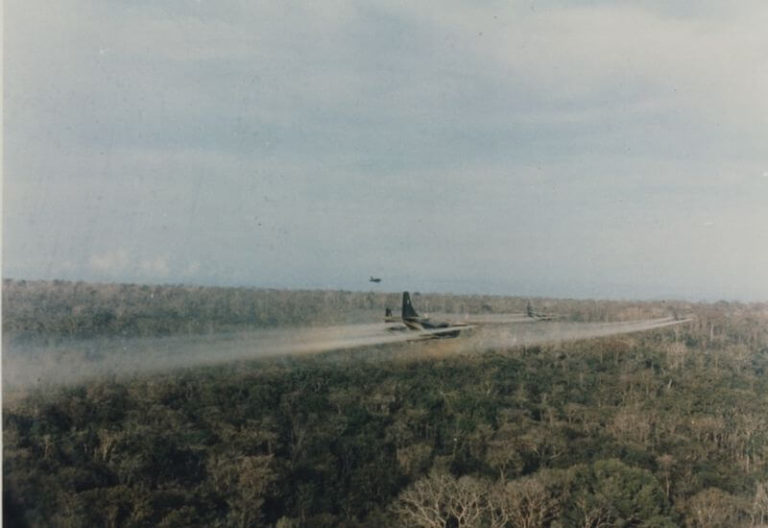7 Things Every Veteran Should Know About Agent Orange

1. What Agent Orange Is and How It Was Used
Agent Orange is an herbicide that was used by the United States during the Vietnam War. Specifically, Agent Orange is a 50/50 mixture of two kinds of herbicide agents: 2,4-D and 2,4,5-T. As a byproduct of its production, Agent Orange also contained the dioxin contaminant 2,3,7,8-TCDD, which is the most toxic of all the numerous dioxins. Agent Orange is just one of the “rainbow herbicides” that the United States used during the Vietnam War including Agent Blue and Agent White, among others.
Agent Orange and other herbicides were used in the Vietnam War for two main purposes: (1) to destroy the enemy’s crops to interrupt their food supply; and (2) to destroy foliage in the jungle and increase visibility to prevent ambush attacks. During the Vietnam War, herbicides including Agent Orange were sprayed mainly in four ways:
- C-123 aircraft were used to spray herbicides over the jungles of Vietnam during Operation Ranch Hand. These C-123 aircraft were modified with tanks to carry the herbicides
- Helicopters were used to spray smaller areas
- Buffalo turbines (i.e. truck-mounted decontamination sprayers) were used to spray roadsides and perimeters
- Hand-held sprayers were also used as a method of spraying herbicides
2. VA’s Presumption of Exposure to Agent Orange and Who Qualifies for It
The Agent Orange Act of 1991 required VA to create a presumption of exposure in which VA will presume that veterans who served in specific locations during defined timeframes were exposed to Agent Orange. A presumption of exposure replaces the element of service connection that requires veterans to provide proof of an in-service event or symptoms that caused their current disability. In these instances, VA presumes veterans were exposed to herbicides during service, and this counts as the in-service event. VA presumes that veterans who served in the following locations during the specified timeframes were exposed to Agent Orange:
- Boots-on-the-ground in Vietnam, veterans with service aboard a ship that operated in the inland waterways of Vietnam (i.e. Brown Water veterans), or veterans with service aboard a ship in Vietnam’s territorial seas (i.e. Blue Water Navy veterans) between January 9, 1962 and May 7, 1975
- On or near the Korean demilitarized zone (DMZ) between September 1, 1967 and August 31, 1971
- Active duty and reservist personnel who had regular contact with C-123 aircraft between 1969 and 1986
3. VA’s List of Presumptive Conditions Associated with Agent Orange Exposure
In addition to the presumption of exposure to herbicide agents, VA affords a presumption of service connection for certain conditions it associates with Agent Orange exposure. The presumption of service connection removes the element of service connection that requires veterans to provide a medical nexus linking their condition to their military service. Instead, if a veteran served in a qualifying time period and location and has one of the following conditions, VA will presume service connection:
- AL Amyloidosis
- Chronic B-Cell Leukemia
- Chloracne (if it presents within one year of exposure to a degree of 10 percent disabling)
- Diabetes Mellitus Type 2
- Hodgkin’s Disease
- Ischemic Heart Disease (including Coronary Artery Disease, stable and unstable angina, myocardial infarction, and sudden cardiac death)
- Multiple Myeloma
- Non-Hodgkin’s Lymphoma
- Parkinson’s Disease
- Peripheral Neuropathy, Early Onset (if it presents within one year of exposure to a degree of 10 percent disabling)
- Porphyria Cutanea Tarda (if it presents within one year of exposure to a degree of 10 percent disabling)
- Prostate Cancer
- Respiratory Cancers, including Lung Cancer
- Soft Tissue Sarcomas (other than osteosarcoma, chondrosarcoma, Kaposi’s sarcoma, and mesothelioma)
It is important to note that if additional disabilities develop as a result of one of the above-mentioned presumptive conditions, veterans can file a service connection claim for the additional disability, as secondary to the herbicide-related disability.

4. Dependents’ Benefits for Effects of Agent Orange Exposure
The effects of Agent Orange have been shown to cause a variety of serious health conditions, and have also been associated with certain birth defects in the children of veterans who were exposed. Children with birth defects acknowledged by VA as associated with herbicide exposure may be eligible for compensation, healthcare benefits, and vocational training. The child must be a biological child of a veteran who served in Vietnam or the Korean DMZ during the presumptive time period, and conceived after the dates during which the veteran served. VA presumes that when male veterans have children with spina bifida (except spina bifida occulta), the condition is due to the veteran’s exposure to herbicides during service. VA presumes certain other birth defects (below) are connected to a veteran’s military service, but only if the veteran is the biological mother who served in Vietnam and the birth defect resulted in permanent physical or mental disability:
- Achondroplasia
- Cleft lip and cleft palate
- Congenital heart disease
- Congenital talipes equinovarus (i.e. clubfoot)
- Esophageal and intestinal atresia
- Hallerman-Streiff syndrome
- Hip dysplasia
- Hirschprung’s disease
- Hydrocephalus due to aqueductal stenosis
- Hypospadias
- Imperforate anus
- Neural tube defects
- Poland syndrome
- Pyloric stenosis
- Syndactyl (i.e. fused digits)
- Tracheaesophageal fistula
- Undescended testicle
- Williams syndrome
5. Agent Orange in Thailand
Veterans who served in Thailand during the Vietnam War are not included in VA’s presumption of exposure. However, VA recognizes that herbicides were used along the perimeter of certain Royal Thai Air Force Bases to increase visibility and prevent guerilla attacks between February 28, 1961 and May 7, 1975. These bases include U-Tapao, Udorn, Ubon, NKP, and Takhli among others. VA contends that only those who worked on or near the perimeter may have been exposed to herbicides. If a veteran’s military occupational specialty was a security guard or patrol dog handler, VA will concede that they were on the perimeter of the base and exposed to herbicides. VA also says that it will concede exposure if veterans can show that they were on or near the perimeter through other credible evidence (e.g. official records or lay evidence). Ultimately, to receive service-connected compensation, veterans must show on a factual basis that they were exposed to herbicides during their service as indicated above, and have a current diagnosis of a presumptive condition associated with herbicide exposure.
6. Nehmer Class Members
Nehmer v. U.S. Department of Veterans Affairs is a 1986 class action lawsuit brought against VA by the National Veterans Legal Services Program. As a result of this case, VA must take certain actions when it recognizes a new condition as scientifically linked to Agent Orange exposure. Specifically, when VA adds a new condition to the presumptive list, it must:
- Identify all claims for the recognized condition that were previously filed and/or denied
- Pay retroactive disability and death benefits to the veterans or their survivors back to the date of the veteran’s initial claim
Importantly, these claims must have been filed or denied between September 25, 1985 and August 31, 2010.
7. Blue Water Navy Veterans Added to Presumption of Exposure to Agent Orange
Blue Water Navy veterans are those who served aboard ships in the open waters off the coast of Vietnam during the Vietnam War. Blue Water Navy veterans include those who did not set foot on the landmass of Vietnam or who never went into the inland waterways of Vietnam, often referred to as “Brown Water” veterans. Historically, VA has excluded Blue Water Navy veterans from its presumption of herbicide agent exposure based on a decision issued in the case Haas v. Peake. However, on January 29, 2019, the Federal Circuit issued a decision in Procopio v. Wilkie, overruling Haas to include Blue Water Navy veterans under the presumption of exposure. Specifically, the Federal Circuit found that “Republic of Vietnam” includes both the country’s landmass and its territorial seas in which Blue Water Navy veterans served. This decision impacts thousands of Blue Water Navy veterans who will now be afforded the same presumption of exposure to herbicides as veterans who served boots-on-the-ground in Vietnam.
About the Author
Share this Post
